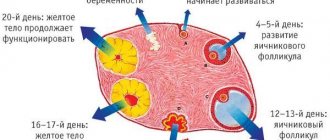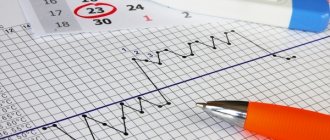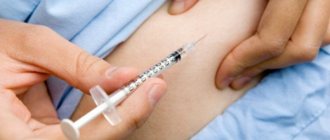Men often joke about women's logic, but how much do they know about a woman's body and its functioning? It happens that the fairer sex themselves are at a loss as to what is happening to them.
One of the important moments in a woman’s life is conception, pregnancy and birth of a child. The process of conception is based on the expectant mother’s knowledge of the body, or more precisely, the monthly cycle, consisting of several phases. A review of information about the duration of the cycle, which differs from the “standard” one, will be useful both for those who want to get pregnant and for those frightened by myths about the abnormality of such a cycle.
What day is it on?
Ovulation is the release of an egg (oocyte) from the ovary.
Breaking the walls of the follicle, it exits into the fallopian tubes. If there are active sperm in them at this moment, there is a high probability of fertilization. When does ovulation occur? In women with a normal and regular cycle of 28–30 days – on days 14–15. But the body cannot work like a machine, so deviations occur - the egg can leave the follicle for 11-21 days.
Important! The duration of ovulation is 12–48 hours, sperm can remain viable for 3–7 days. These factors should be taken into account by girls who do not plan to become a mother in the near future. 5 days before and after the expected date of release of the egg, you should use barrier contraception.
The release of an egg from the ovary is accompanied by certain hormonal changes. Ovulation can be determined by a number of characteristic signs that appear equally in women with any length of the menstrual cycle.
Main symptoms of ovulation:
- Change in the appearance and consistency of vaginal discharge - during ovulation, the cervical fluid becomes viscous and transparent, which facilitates the movement of the egg and sperm. The color of mucus can be white, yellow, pink.
- The amount of natural lubrication during sexual intercourse increases.
- The mammary glands slightly increase in volume, hurt, and their sensitivity increases.
- The position of the cervix changes - it rises higher and becomes softer.
- Increased libido against the background of a hormonal surge, the body gives signals of readiness for conception.
- Minor spotting discharge - appears after follicle rupture.
- Pain and spasms in the lower abdomen, most often on one side, occur when the walls of the follicle rupture, contraction of the fallopian tube, or during the movement of the egg. Normally, the discomfort is short-lived.
Additional symptoms at the end of ovulation most often include bloating, upset bowel movements, increased appetite, headache, and mood swings.
Long cycle
Long menstrual cycle – 35–45 days. Since the stage of the corpus luteum is approximately the same for all women, to determine ovulation with a long cycle you need to subtract 14 from its duration.
For example, with a cycle of 35 days, the calculation scheme is as follows: 35 – 14 = 21, ovulation should occur on the 21st day.
Average cycle
The average is the menstrual cycle, which lasts 28–32 days, with menstrual flow observed for 3–5 days. Ovulation occurs after 12–15 days, with a 32-day cycle - after 18 days, but it all depends on the individual characteristics of the body.
How many days after ovulation will the test show pregnancy? A faint second line may appear on the test 6–12 days later when the embryo implants. Exactly on what day this will happen depends on your hormonal levels.
Short
The duration of a short cycle is less than 25–26 days. To calculate the day the egg is released, you need to subtract 14 from the length of the cycle, for example, 25 – 14 = 11. The favorable period for conception will occur on the 11th day after menstruation.
If the menstrual cycle consistently lasts less than 21 days, the gynecologist can diagnose polymenorrhea; in such cases, ovulation often occurs immediately after menstruation, on the 7th–8th day.
Irregular cycle
To calculate the favorable period for conception with an irregular cycle, a lot of effort will be required - keeping a chart, measuring basal temperature regularly throughout the year.
To calculate the ovulation period, you need to subtract 11 from the longest cycle, and 18 from the shortest. The resulting values will show the period during which conception can occur, but with an irregular cycle, these indicators can be a week or more.
Table of approximate ovulation dates
| Cycle length (days) | On what day after menstruation is the egg released? |
| 21 | 5-9 |
| 23-25 | 7-13 |
| 26-29 | 10-17 |
| 30-32 | 14-20 |
| 33-35 | 17-23 |
| 36-38 | 20-26 |
| 38-40 | 22-28 |
How to determine ovulation
To calculate the moment of ovulation, it is necessary to accurately determine the duration of the menstrual cycle. To do this, you need to record the start date of menstruation for 3-6 months. This will help establish the regularity and duration of menstruation, which will undoubtedly make it easier to calculate days suitable for conception.
So, it has been established that the cycle is 25 days. We know that the duration of the second phase is 14 days, regardless of the duration of the menstrual cycle. The following calculations must be made:
- 25-14=11
Where 25 is the menstrual cycle, 14 is the average duration of the luteal phase. We get the number 11, which must be counted from the first day of menstruation. This will be the date when ovulation is expected to occur and the egg enters the fallopian tube.
Fertile days
In a woman, a few days before and after ovulation, the level of fertility increases, a condition in which conception is most likely. Therefore, the most successful time for conception with a cycle of 25 days begins on the 7th day and lasts until the 15th day.
According to the Ogino-Knaus method, fertile days are calculated using the following formula:
- Subtract the constant number 18 from the shortest cycle (25-18=7). The resulting number will mark the beginning of the fertile period.
These calculations do not provide accurate and very approximate information, so it is worth using other methods.
Additional Methods
There are several additional techniques.
- Ovulation test. You can purchase such a device at a pharmacy. There are several types of tests: paper indicators, digital test, reusable test, inkjet test. It is considered the most reliable method.
- Tracking ovulation symptoms - ovulatory syndrome. It is believed that the moment the egg is released is asymptomatic, but many women are able to feel ovulation. Ovulatory syndrome is manifested by small stabbing pains in the lower abdomen, mainly on the side of egg maturation (left, right).
- Condition of cervical mucus. On the last day of your period, you need to start tracking the quality of cervical mucus, and write down the data in a prepared notebook. On days when conception is less likely, the vagina is dry and the discharge is thick (or absent). As fertile days approach, the mucus becomes thinner. On the days of ovulation, the discharge resembles “egg white”; it becomes viscous and transparent. Subsequently, the mucus acquires a thicker consistency, gradually disappearing completely. The peak possibility of conception occurs with a discharge similar to “egg white.”
- Measuring basal temperature. The method is based on measuring the temperature in the vagina immediately after waking up in the morning. These measurements are systematically entered into a notebook. About a day before the release of the egg, the temperature drops slightly. At the time of ovulation, the data exceeds the usual values by 0.3-0.6ºC. It is necessary to monitor your basal temperature for several months, and build a graph based on the measurement results. This method, in addition to tracking ovulation, helps to identify irregularities in the menstrual cycle and the possible cause of infertility.
Cycle change
Early or late ovulation is quite common. Most often, such deviations are associated with hormonal imbalance, which causes disturbances in the hypothalamus-pituitary-ovarian ligament. Permissible deviations in the timing of ovulation are 1–3 days.
Late ovulation - the release of the egg occurs later than the 20th day of the cycle, often observed before the onset of menopause. This pathology increases the risk of chromosomal abnormalities, congenital defects in the child, and miscarriage.
Why does the ovulatory period lengthen:
- hypothyroidism, hyperthyroidism;
- benign neoplasms in the pituitary gland;
- adrenal insufficiency;
- severe stress;
- physical fatigue, intense training;
- a sharp decrease or increase in weight by more than 10%;
- chemotherapy;
- long-term use of hormonal drugs.
Late ovulation also occurs during breastfeeding. When menstruation returns after childbirth, a long follicular phase can be observed for six months. This phenomenon is considered normal, as the body prevents re-pregnancy.
Early ovulation
Early ovulation - in a normal cycle, the egg leaves the follicle before the 11th day; it is not suitable for fertilization. Additionally, there is a mucus plug in the cervix, which prevents the penetration of sperm, the endometrium is still too thin, and high levels of estrogen prevent the implantation of the embryo.
Reasons for early ovulation:
- stress, nervous tension;
- natural aging – a high level of FGS is observed in the body, which provokes active growth of follicles;
- smoking, alcohol abuse, coffee;
- endocrine and gynecological diseases;
- recent abortion;
- cancellation of oral contraceptives.
Important! On average, for each year of taking OCs, it takes 3 months to restore the normal ovulatory period.
Atypical cases of ovulation
Can you ovulate twice in one cycle? In rare cases, 2 eggs are released into the fallopian tubes at once. Follicle rupture occurs in one of the ovaries with a difference of several days, or in both ovaries simultaneously.
Concept of ovulation
During ovulation, the egg leaves the ovaries and moves through the fallopian tubes, creating the most favorable time for fertilization. This condition is ovulation and its duration on average is no more than a day. All calculations are associated with this process to determine the days required for fertilization. Ovulation occurs in the middle of the menstrual cycle, it is preceded by the follicular phase with the maturation of the egg, and ends with the subsequent luteal phase, lasting 14 days. The moment the egg is released is accompanied by an increase in the level of luteinizing hormones, which helps determine the moment of ovulation using tests. It all ends with the beginning of a woman’s next period, the first day of which marks the beginning of a new cycle.
Ovulation during a menstrual cycle of 26 days
On average, the duration of the menstrual cycle is taken to be 28 days. But this value can change in one direction or another, for example, with a 26-day cycle, 26 days pass between menstruation. If the goal of a married couple is the desired pregnancy, then use the following calculation:
From the duration of the entire cycle of 26 days, a constant value is subtracted, that is, 14 days, the resulting number of days is counted from the start of menstruation, and unprotected sexual intercourse is performed on the resulting date. If pregnancy is not currently part of your plans, it is necessary to increase precautions during these dangerous days.
Using the test You can also determine the moments of ovulation using test strips, which are offered in every pharmacy. The instructions describe in detail how they are used for testing. The tests work to determine the increased concentration of the hormone in the urine, which happens a couple of hours before the egg is ready to ovulate. With a duration of 26 days, the test must be used starting from 9 days from the first day of menstruation.
Monitoring your basal temperature
It is also important to monitor changes in basal temperature, measurements of which are carried out rectally in the morning, without getting out of bed. There is a slight decrease in temperature, and at the moment the egg ready for ovulation is released, its slight increase.
Menstrual cycle and ovulation
To answer the questions, you need to understand what the menstrual cycle and ovulation are.
Every girl between the ages of 12 and 16 experiences her first period, menarche (first menstruation). At first, menstruation is scanty, irregular, and may be absent for 1-2 months. However, later, within 1-2 years, the formation of the cycle occurs. Menstruation becomes regular, with the same length of days of discharge. This means that the menstrual cycle acquires its own rhythm, which is subject to the individual characteristics of the woman.
From what day should the beginning of the menstrual cycle be counted? In medicine, the conventional day of the beginning of the monthly cycle is considered to be the first day of menstruation.
The onset of menstruation indicates that fertilization has not taken place. From this moment, the endometrium, the mucous membrane of the uterus, is renewed, and the process of formation of several follicles begins in the ovaries. After about 7-9 days, the dominant follicle begins to be determined, and the rest experience reverse development, that is, they undergo regression.
The dominant follicle continues to develop and by the middle of the cycle turns into a Graafian vesicle, that is, a follicle that is fully mature and ready for ovulation. At this time, a wave release of certain hormones occurs in the woman’s body. The bubble bursts, and the mature egg is released. The most favorable days for conception are coming.
The duration of the first phase - follicular - is not constant and depends on the individual characteristics of the woman’s body. Depending on the length of the cycle, the final maturation of the egg occurs from 7 to 22 days. The average duration is 14 days.
The average duration of the ovulatory phase is 3-4 days, that is, 36-48 hours.
The second phase is a more constant value and practically does not depend on the duration of the menstrual cycle. The duration of the luteal phase is from 13 to 14 days, fluctuations of 1-2 days in any direction are possible.
Ovulation with a cycle of 27 days
Knowledge about the moment of onset of ovulation is necessary in the following situations:
- know about the duration of your menstrual cycle due to timely detection of deviations in the state of reproductive functions;
- get the maximum opportunity for conception;
- prevent unwanted pregnancy.
When dreaming of motherhood, a woman must take serious care of the health of her body. In order to safely carry and give birth to a healthy baby, she must pass the necessary tests and undergo examinations that make it possible to identify pathological abnormalities at the most basic level. Knowing the favorable time for conception will also not be superfluous, since a favorable result will largely depend on the psychological mood. With a 27-day cycle, the ovulation period is calculated using the same formula: subtract 14 from 27 to get the number at which the moment of ovulation occurs, if you add it to the beginning of the menstrual cycle. It should be remembered that the period of ovulation is short-lived and in order not to miss the moment of conception, it is necessary to take into account its symptoms.
Is a 24-day cycle normal or a cause for concern?
I really don’t want to go to the doctor when something goes wrong in my body. But how can you understand whether this is the norm or a deviation? A woman’s body is a delicate matter that responds to all changes in mood, amount and strength of stress, nutrition, stress and even climate. And inconstancy is a common thing for every woman. It surrounds you always and everywhere. No stability. What to do when the body reacts to the instability of the rhythm of life by shortening the cycle?
It is believed that the normal duration of the menstrual cycle of a healthy woman is 28 days; most contraceptive drugs are aimed at this duration, which after 4 weeks cause monthly bleeding. However, this does not mean that a longer or shorter cycle is a pathology. Modern medical professionals have found that the main thing is regularity, and the duration of the cycle can vary from 21 to 34 days. The main reasons for duration deviations may be:
- age;
- change of work and rest modes;
- nutrition;
- taking medications;
- presence of bad habits;
- stressful situations;
- changes in intimate life.
A common number that women note as the length of their monthly cycle is 24 days. This duration is the norm and is definitely not an obstacle in planning a pregnancy, so you don’t need to spend 24 hours looking for treatment for this. In the absence of pathological symptoms and normal amount, color, consistency of discharge, there is no reason to worry. Women who want to get pregnant ask an important question: if the cycle is 24 days, when will ovulation occur?
Phase characteristics
The 26-day menstrual cycle consists of several stages. The first phase begins with menstruation. Each cycle should be counted from the beginning of the next menstruation.
By the end of menstruation, the next phase begins - the estrogen phase. At this time, increased levels of estrogen and follicle-stimulating hormone are detected. FSH is involved in the formation of a dominant follicle. In its cavity there is an egg. It will ripen within a few days. The average duration of these phases can be 12 days. In rare cases, follicle maturation occurs on the tenth day.
FSH and estrogen are replaced by luteinizing hormone. It increases the volume of fluid present in the follicle. Its shell cannot withstand the pressure and ruptures. This is the beginning of ovulation. The lifespan of an egg can be 24 hours. During this time, she needs to meet the sperm and form a zygote. If this does not happen, the egg quickly dies.
After this, the final stage of the cycle begins - the progesterone stage. Progesterone helps the egg to attach tightly to the endometrium. After the formation of the zygote, progesterone participates in its nutrition. In the absence of pregnancy, progesterone levels decrease. The next menstrual cycle begins.
Signs of Fertility
To understand when ovulation occurs in a 26-day cycle, you should study its signs. There are several signs of its onset. A woman should pay attention to the appearance of mucous discharge from the vagina. The beginning of the cycle is accompanied by light mucous discharge. Mucus is produced by glands that line the cervical canal.
Luteinizing hormone causes the channel to gradually open. The glands begin to produce fluid more actively. This is necessary to prevent unwanted infection of the genitals. The quality of mucus gradually changes. It becomes more viscous. The white color changes to transparent. The glassy substance should stretch well. To check this, you need to squeeze a small amount of discharge between your fingers. When they move apart, the mucus should not separate from the pads. It stretches a lot. This quality of mucus is necessary to increase the chances of conception. Sperm easily penetrate the uterus through such secretions. It is on these days that you should plan your pregnancy.
An indirect sign is pain in the mammary glands. The chest hurts due to the action of prolactin. The hormone is involved in lactation. Under its influence, the glandular layer begins to increase. The tissue puts pressure on the muscles and halos. There is tingling in the nipples and a feeling of heaviness in the chest. The mammary glands increase significantly in size. But this symptom does not always indicate ovulation. Sometimes it can appear due to pregnancy or inflammation in the glands.
There is also an increase in sexual activity. Libido completely depends on a woman's hormonal background. Activity increases under the influence of luteinizing hormone. The hormone is produced in the pituitary gland. This department makes other parts of the brain work harder. After ovulation, sexual activity returns to normal.
An indirect sign of ovulation is pain in the lower peritoneum. Many patients believe that pain occurs due to sudden growth of the follicle or its rupture. Also, the reason may lie in the location of the uterine cavity. But pain is not always considered a symptom of ovulation. The cause may be inflammation of the appendages or a bacterial infection. To determine the cause of the pain, you need to seek help from a specialist.
Home methods for determining favorable days
With a 26-day cycle, the onset of ovulation can be determined in various ways. A woman can install it at home. To do this, you can use the following methods:
- building a temperature graph;
- study of external signs;
- testing;
- microscopic analysis.
The most accurate method for independently determining ovulation is to construct a temperature graph. A woman's basal temperature depends on her hormonal levels. Under the influence of a luteinizing substance, the temperature decreases. Progesterone causes an increase in indicators.
To build a table correctly, you need to use several rules. It is recommended to take measurements in the morning. After sleep, temperature readings stabilize. To avoid getting an erroneous result, a woman should not make any movements. You should also use a mercury thermometer. This thermometer shows accurate results within 5 minutes. Using an electronic thermometer may result in erroneous graphing. This happens due to the nature of their work. The electronic thermometer continues to measure after the signal to stop operation is given. A mercury thermometer stops measuring after 5 minutes.
The thermometer should be kept close to the bed. This will reduce physical activity. It is also recommended to avoid sexual contact in the morning. It will change your body temperature. The schedule will be wrong. Each result is recorded in a special chart. Connecting the dots allows you to build a basal temperature graph.
Other Common Methods
You can use another simpler method. To do this, you need to purchase several ovulation tests. With a 26-day cycle, strips must be used from the day you stop menstruation. Only one strip should be used per day. The surface of the dough is treated with two types of reagents. The control zone turns red when it comes into contact with a woman's urine. The test area undergoes a reaction with luteinizing hormone. LH is always present in a woman's urine in small quantities. As ovulation approaches, its amount increases. The reaction becomes more intense.
Comparison of stripes by color is considered a positive result. From this day on, you need to start planning your pregnancy.
There are a large number of tests. Manufacturers offer cassette, inkjet and litmus tests. The most convenient to use is the jet test. It should be placed under a stream of urine. In a few seconds it will show the result.
You can use a home microscope for ovulation. With a 26-day cycle, the microscope should be used from the sixth day. Saliva is applied to the microscope field. She gives an image. During ovulation, the picture resembles a clover leaf. This image appears with increased levels of luteinizing hormone.
To determine ovulation in a 26-day cycle, another effective method should be used. It is carried out by a specialist. To determine ovulation, a woman must attend an ultrasound diagnosis. Diagnosis is carried out every other day. The specialist determines the presence of a large follicle. The dominant has a large diameter and is significantly different from other neoplasms on the ovary.
A day later, the doctor examines its size. They should increase by 2–4 mm. By the time the egg matures, the follicle reaches 23 mm. On this day you need to start conceiving. Ovulation should occur the next day.
After 2 days, the woman should visit an ultrasound to monitor the ovulation that has occurred. The doctor should note the absence of a follicle on the screen. Fluid should be detected in the retrouterine space. She can only be seen for two days. After this, it is absorbed into the peritoneal wall.
This technique is the most popular and effective. Many women ask when a cycle of 26 days will ovulate. To do this, you should use one of the proposed methods. If the cycle is not stable, then several methods should be used simultaneously. This will allow you to more accurately determine the approach of the fertile period.
When and at what time does the ovulatory phase begin?
It has been scientifically proven that ovulation for any woman always occurs two weeks before the start of menstruation, and the number of days in the cycle does not affect this in any way.
The length of the first phase of the cycle (before menstruation) may vary slightly, but the second phase, most often, remains unchanged.
What determines a timely process?
- The woman’s well-being, the presence or absence of illness.
- Hormonal levels - climate change. With a sharp change in climate, the cycle may shift slightly.
- The presence or absence of stress.
Ovulation is the middle of the cycle . During this period, many processes occur in the female body.
- The level of follicle-stimulating hormone decreases.
- There is a release of luteinizing hormone, which makes the uterus very receptive to male sperm.
- The egg completes its maturation, after which it is released from the follicle and enters the fallopian tubes, where it will await conception.
How to calculate the onset of the ovulatory phase?
There are several ways to calculate ovulation, which are also suitable for a 25-day cycle.
- The calendar method is an independent study of the duration of the cycle. First, the start date of menstruation is noted, after which 25 days are counted - this will already be the start date of the next cycle. From 25, 14 should be subtracted, that is, the approximate date of ovulation will be the eleventh day of the cycle. Although this method is easy to use, it can hardly be called accurate. Gynecologists often advise subtracting two more days from this number. That is, with a cycle of twenty-five days, ovulation occurs on the eighth day.
- Test strips . The test is carried out in exactly the same way as the pregnancy test familiar to all women: the luteinizing hormone in the urine reacts with the chemical elements in the strip.
- Determining ovulation by external signs of the body:
- the volume of mucus secreted increases;
- sexual activity increases;
- swelling and tenderness of the breast.
- Folliculometry is a medical procedure using an ultrasound machine, the most accurate and reliable of all those presented above.
The method of external signs can be called the most unreliable, but, nevertheless, women who know their body well use it without problems.
Introduction to the concept of ovulation
A mature egg enters the fallopian tubes from the ovary. This moment, when fertilization is most favorable, is called ovulation. Its duration is only a day, which is associated with all the problems and questions about the possibility of correctly calculating the “necessary” days. It is preceded by the follicular phase, when the egg matures, and ends with the luteal phase, which lasts 14 days. The release of the cell is accompanied by an increase in the level of luteinizing hormone, which allows you to use test strips to determine a favorable day (Read more on what day to do an ovulation test). The whole process ends with the next menstruation, the first day of which gives rise to a new cycle.
Calculation of the day of ovulation with a cycle of 26 days
The most typical period is 28 days, but consider a different situation: a cycle of 26 days. This means that only 26 days pass between the previous and subsequent first day of menstruation.
After calculating the day of ovulation, it is recommended to start using the test 1-2 days before this date
Our second phase is constant – 14 days. Therefore, it should be subtracted from the duration of the cycle: 26-14 = 12. Having counted 12 days from the beginning of bleeding, a woman needs to have sexual intercourse the day before and on that day. If it is not desirable for her to become pregnant at the moment, then, on the contrary, increased precautions should be taken during this period of time.
We check it on the test
You can also find out the day of ovulation using a test that is sold everywhere in pharmacies. They contain detailed instructions and rules for conducting tests. The principle of their action is to determine the highest concentration of luteinizing hormone in the urine, which happens several hours before the cell transitions to the position of readiness for fertilization.
With a 26-day cycle, tests begin 9 days after the first day of the cycle. The formula looks similar to that described above, but you need to subtract 17 (luteal phase + ovulation).
Basal temperature chart
It is also permissible to create your own basal temperature chart. It is formed by taking rectal temperature measurements (depth 3-5 cm) every morning, while remaining in bed without moving. It is better to do this for 3-6 months to get a clearer picture. By connecting the measurement points, you get a graph. A slight decrease and then increase in temperature occurs at the time of ovulation.
With a 26-day cycle, you can plot your basal temperature and understand on what day ovulation begins
The most accurate method is, of course, ultrasound. This way you can observe the development of the cell at each stage and reliably know the period.
Is a short monthly period normal?
The menstrual or monthly cycle is a reproductive physiological process, characteristic only of sexually mature women , as a result of the work of a whole range of hormones. This process is regular, that is, monthly, but despite this, many women, throughout their lives, do not know about the length of their cycle, and also do not know how to calculate it correctly.
To calculate your cycle, you need to start counting from the first day of bleeding, even minor ones, and end with the last day before the next menstruation.
The average cycle length is considered to be 28 days . But this means precisely that this figure is the statistical average, and the norm in gynecology is considered to be deviations per week. That is, if the cycle lasts 21 days or 35 days, this is completely normal and not a reason to worry. In particular, a cycle of 25 days is the absolute norm and occurs quite often.











